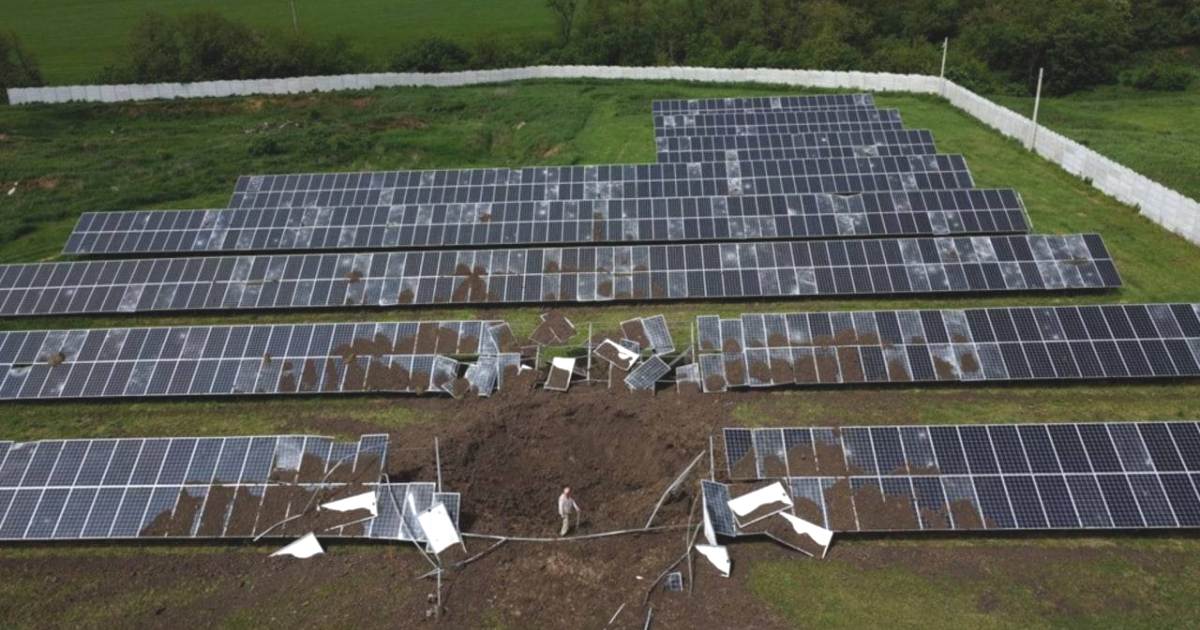
Image: Solar Generation, LLC
Tough times continue in Ukraine for just about everyone and everything – including the nation’s renewable energy sector.
Prior to Russia’s invasion, renewables were making slow but steady headway in Ukraine; rising from under 2 percent of the energy mix in 2009 to 11 percent in 2020. Then last year a goal was set to source 25 percent of Ukraine’s total energy requirements from renewables by 2035.
Things were looking pretty bright on this front for Ukraine, then Putin.
We’ve seen various reports of wind and solar farms being bombed over the months since. But even in the midst of all the carnage, there were ongoing discussions about progressing renewables in the country – including at the Switzerland hosted Ukraine Recovery Conference (URC 2022) in Lugano.
A policy brief on environmental recovery states:
“Develop additional 30GW of RES that will ensure the decarbonization of the energy sector and reduction of the air pollution, produce hydrogen and export it to the EU in order to strengthen energy resilience of Europe and reduce the dependency of Russia.”
But before recovery can begin, the current situation has to be resolved – and Ukraine’s energy infrastructure is still copping a pounding from the Kremlin; including wind and solar farms.
The brief mentioned above noted “2.6 GWh” (assumed to mean 2.6 GW) of renewable energy capacity was in “temporarily occupied territories” as at July. Earlier, in March, the Ukraine Association of Renewable Energy said 47% of the country’s renewable energy capacity was located in regions where active hostilities were occurring at that time.
Green Energy “Most Affected” Industry
According to a report from the National News Agency of Ukraine (Ukrinform1), Ukrainian Energy Minister Herman Halushchenko recently indicated 90% of wind power facilities and 45-50% of solar energy facilities in Ukraine are out of action.
“Green energy is probably the most affected industry, as most of our capacities have been located in southern Ukraine,” Mr. Halushchenko said. “These are huge losses.”
Last week, Ukrainian President Volodymyr Zelenskyy said 30% of all Ukraine’s power stations had been destroyed since October 10, causing massive blackouts across the country
Unlike a coal-fired power station, it’s pretty hard to bomb the crap out of an entire large wind or solar farm given the large areas used. But that doesn’t have to happen to knock power stations – renewable or fossil fuel based – off the grid. Then it’s a matter of being able to get in to do the necessary repairs; no mean feat in occupied territory or when supplies/personnel for repairs may be hard to source. Carrying out those repairs can be pretty risky with rockets, kamikaze drones and the like still whizzing about the place.
Where crews can get in, repairs to solar farms can be made pretty quickly. This was demonstrated after a Russian missile hit a 3.9 MW solar power station in Kharkiv in late May (pictured above). It was able to recommence partial operations within just a few days.
Minister Halushchenko is looking past all this destruction and is still optimistic about the future for renewables in his country. In terms of the 25% by 2035 (stated in the report as 2030) target:
“I think, after our victory and considering the destructions caused by Russia, we will revise it and increase the share,” Halushchenko noted.
The ongoing positive mindset in the face of such relentless onslaught over months is encouraging – more (renewable) power to them all.
Related: Reduce Gas Use For Ukraine!
Footnotes
- Ukrinform was founded in 1918 during another war – the Ukrainian War of Independence. ↩

 RSS - Posts
RSS - Posts



I remain a skeptic of renewable energy aka intermittent energy, however one of the premises behind the internet as I recall was the notion of multiple nodes or perhaps multiple pathways so that in the event of a nuclear exchange, the loss of some, perhaps even many, wouldn’t preclude said network from continuing to operate.
The largest nuclear powerplant in Europe (5700 MW) is located in the Ukraine – currently occupied by Russian forces. Roughly 400 km west there’s a second nuclear powerplant in southern Ukraine – a mere 2850 MW, and a further 2 in NW Ukraine providing 4657 MW. Altogether these 4 plants provide 24% of Ukrainian power.
There appear to be 18 thermal power plants in the Ukraine with coal providing 29% power, gas 28%, and oil 14%, however half of these are on the south or east side of the Dnieper River – think Danube or Rhine, though not all remain in occupied territory.
I’m not quite sure where the renewable was 11% in 2020 claim comes from given 2021 figures showing hydro 3%, wind 1%, and solar 2%. (https://ourworldindata.org/grapher/primary-energy-source-bar?country=UKR~AUS~CHN)
Note too that the Kakhovka Hydroelectric Station – roughly 200 km downriver of Zaporizhzhia, is also occupied by Russian forces and there are fears they will blow the dam to wipe out towns and cities downriver.
There appear to be 10 solar farms in the Ukraine – 2 of these in occupied Crimea, and 9 wind farms.
While I make no claims the above info is perfectly accurate, the notion that 95% of Ukrainian power comes from a mere 22 targets is … risky given Russia’s wilful disregard for the Geneva Convention. If renewable options provide for more reliable energy than bombed out alternatives …
Something for Australian defence planners to think about???